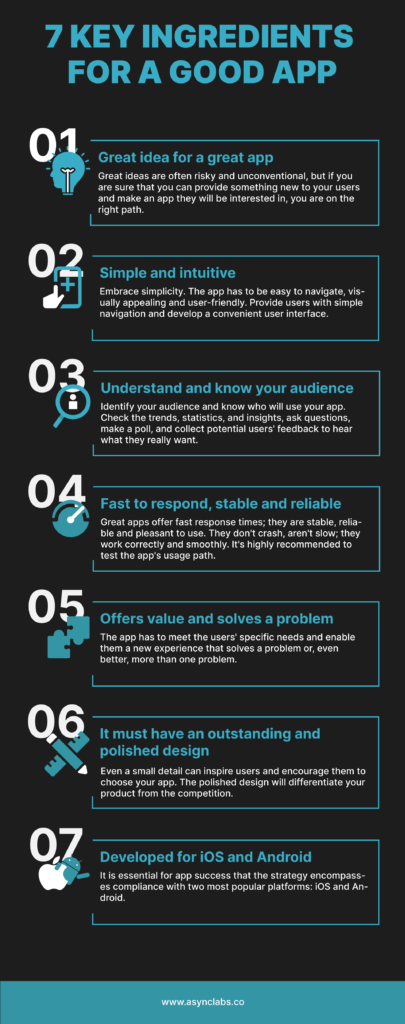Did you know that there is a contest for the best app?
Originality, user interface, usability, and creativity are some of the crucial things when it comes to choosing the best app across all app markets in 2020.
According to Statista, in 2023, mobile apps are projected to generate more than 935 billion U.S. dollars in revenues via paid downloads and in-app advertising.
Mobile applications are part of our daily lives. For many people, they have become a basic human need.
Many companies nowadays can significantly profit with a mobile app. Having an app is an excellent way to keep existing customers and possibly attract new ones. However, it’s not enough to have an app. It has to be unique and provide an excellent user experience.
But the real question is…
What makes a good app?
A great idea for an application solves a specific problem for the target group of potential users. Facebook, Instagram, WhatsApp, and TikTok are just some of the successful apps that have become a part of our daily routine.
One thing they have in common – attracting app concepts reflected in useful functionality.
The great app delivers value to your users and focuses on building an excellent user experience. There are many factors in the process of making a successful application.
Here are seven key ingredients that will help determine the success of your app. Prepare ingredients, mix them and bake to perfection!

1. Great idea for a great app
There is no great app without a great and unique idea. But having a great idea doesn’t mean that everyone’s going to like it. Before you start developing your idea, research the market and user’s needs.
Great ideas are often risky and unconventional, but if you are sure that you can provide something new to your users and make an app they will be interested in, you are on the right path.
Just because everyone agrees on a particular idea, it doesn’t mean the idea is great.
You need to make sure there’s a market for your idea. The idea should be validated on the market by independent, real people. If it is determined that there is a need for an app, the next step is to start with implementing and developing the idea.
Always trust your gut and never choose the safest option. Make a step forward and choose something that no one has done before. Believe in your goals and be adventurous enough to make a unique app that will be useful in the long term.
2. Simple and intuitive
Embrace simplicity.
The app has to be easy to navigate, visually appealing, and user-friendly.
Provide users with simple navigation and develop a convenient user interface. This way, you are on a good path to make a great and intuitive app that users can quickly figure out how to use.
Don’t waste their time and don’t complicate things. Do users a favor and solve their problems in a simple way. When the app is understandable and straightforward, users tend to stick to your app and usually recommend it to new users.
Make it simple and you will have more of a chance to succeed. For example, offering registration via social networks usually takes only two taps, which gives users more options to register faster without spending extra time.
3. Understand and know your audience
A great application is designed for the audience.
First, you need to identify your audience and know who will use your app. Check the trends, statistics, and insights, ask questions, make a poll, and collect potential users’ feedback.
You can collect demographic data like age, gender, location, and gather information about users’ behaviors and motivations.
Don’t spend money on developing apps that customers don’t need or won’t use. Instead, reach out to users through social media and similar platforms to truly hear what your potential customers want.
After you make research, it is time to narrow down the target audience and focus on meeting their specific needs. You have to find people that will appreciate your idea and that will consume your content.
Focus is important. The more you focus on developing specific, additional features and content that will appeal to particular people, the better chances you have in making a good application.
4. Fast to respond, stable and reliable
Speed is the key.
Users want a smooth, fast and seamless experience with their phones. The app performance has to meet the users’ needs on every level.
Great apps offer fast response time; they are stable, reliable, and pleasant to use. They work correctly, smoothly, aren’t slow, and don’t crash.
It’s highly recommended to test the app’s usage path and put yourself in the user’s shoes so developers can improve the app before its release in app stores.
If you find it hard to follow the app guideline, then someone else may feel the same way.
5. Offers value and solves a problem
A useful application should benefit the users, motivate them and give them a reason to download an app and use it. It smartly combines business objectives, consumer needs, and technological solutions.
The unique value may be related to the price, utility, how an application works, or provides access to features, entertainment, convenience, etc.
The app has to meet the users’ specific needs and enable them a new experience that solves a problem or, even better, more than one problem.
Let’s take a banking business service for customers as an example.
Although they have a website that allows access to all customers, many banks also release an app with the same function. Customers can use the service on the website or install an app on their mobile device and use it for the same purpose anytime.
6. It must have an outstanding and polished design
Details matter.
Even a small detail can inspire users and encourage them to choose your app. The polished design will differentiate your product from the competition.
The design should be modern, intuitive, and simple. The content is also essential. It should be as simple as possible, say a lot in a few words, and be in synergy with the illustration.
Exciting graphics, animations, interactions, and unique sound effects can change the experience for the better.
Eliminate unnecessary features that confuse users. Developers have to think about the primary content that users will attach to, create a logical user’s path and make it easy to use.
7. Developed for iOS and Android
It is essential for app success that the strategy encompasses compliance with the two most popular platforms: iOS and Android.
The question is which platform is best to build on first. The best answer to this question is to develop both apps simultaneously. When building on one platform, the first step is to test it, get feedback, make iterations, and then build the other one.
An efficient way to do this is to implement a cross-platform app development framework.
Cross-platform app development tools allow you to create two apps simultaneously, for both iOS and Android. These tools can reduce the time and costs associated with developing apps separately on both platforms.
When you are on a limited budget, this is the most cost-effective approach for designing, optimized and styled apps for more than one device type.
Although faster and cheaper, cross-platform solutions are of lower quality than native applications.
A native application is a software program developed for a particular platform or device and its specific OS (Android or iOS).
Native apps can provide optimized performance and take advantage of the latest technology, such as a GPS, compared to web apps or mobile cloud apps developed to be generic across multiple systems.
The term native app, in the context of mobile web apps, is used for any application written to work on a specific device platform.
Native app development has many advantages. It simplifies the interaction between a UI/UX specialist and a programmer. As a result, the user intuitively interacts with the app’s interface. But all good things have a price. Since more time and effort is put into development and support, the costs are higher.
If you’re planning to run your mobile app, you probably have an idea in your head of how that app should look and work. But for an app to be great, useful, and to attract users, it has to meet some of these criteria.
Focus on these seven criteria and the chances to make it to the top app will be pretty high.
How do we make great apps?
One of the projects we successfully worked on and finished is Bizar. Bizar is the only app you will ever need for business and project collaboration. It is a platform where you can find all the data you need to manage projects successfully.
Another example is MyBeeLine BeeRM, an app created for beekeepers. It is a perfect replacement for paper and pen in the apiary.
The BeeRM application allows beekeepers to successfully optimize their work, manage information more efficiently, track and record costs and inventory, increase yields and improve beekeeping activities.
When we get a project, we invest more time in a discovery workshop, to get a clear picture of what the application should do and what the user wants from the application.
Then we insert expert knowledge on how to improve the app and we start with design.
We are often in contact and on the same truck with the client, with whom we check the direction we are going.
Also, we are always looking for a better way to do our apps and we include all previous experiences in new projects.
It is not an easy task to develop and deliver a great app. Everything starts with brilliant ideas, a good understanding of the high-end users, their behavior, and habits, and ends with excellent implementation.
Do you have a great idea and want to make an even greater app? Let’s do some work together!
To find out what Async Labs can do for your business, get in touch with us today!
